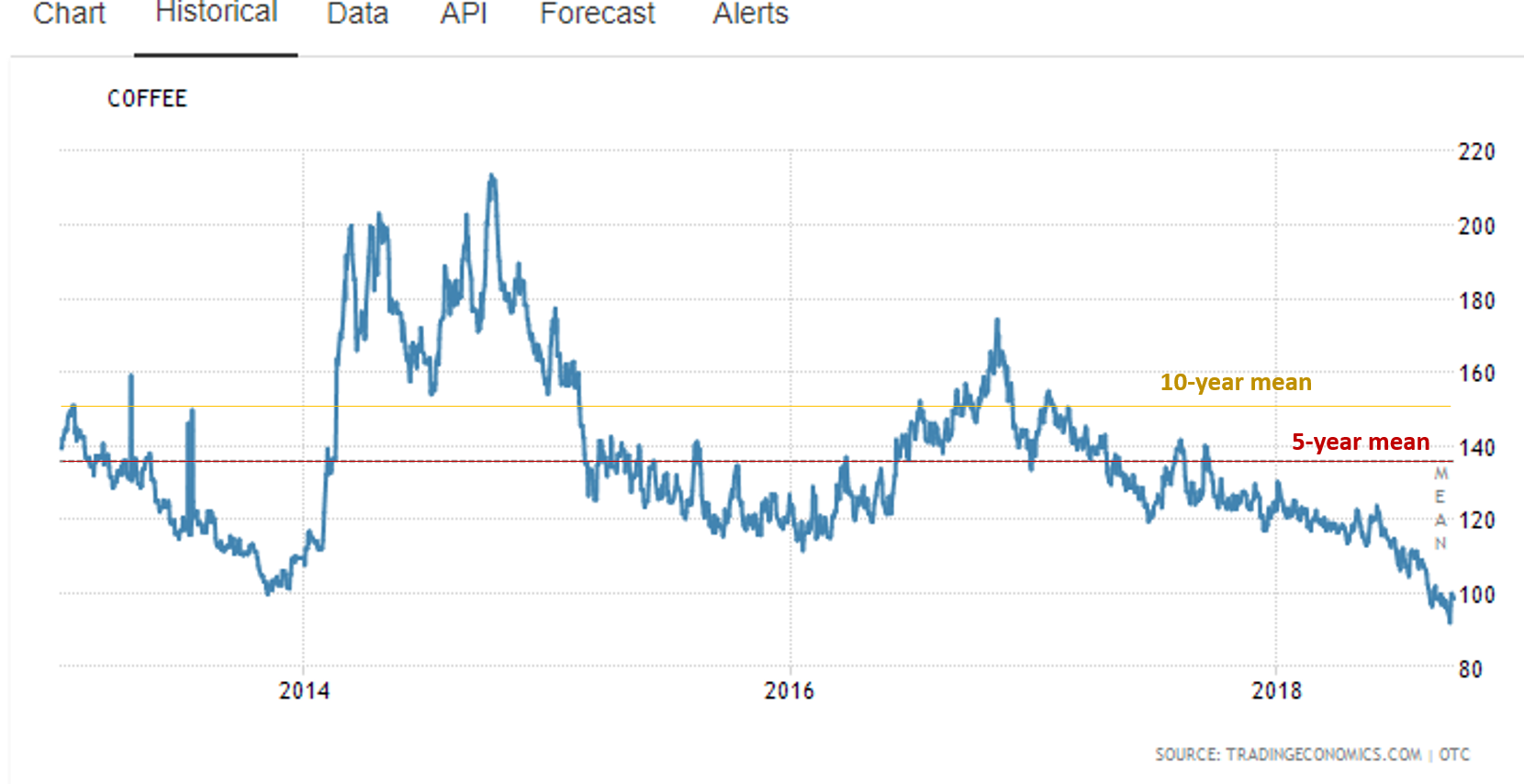There is an urgent need to fix the coffee market: to reduce price volatility and ensure that a fairer share of coffee revenue reaches farmers and farmworkers.
In a recent post, I made the point that the coffee market is unjust because farmers and farmworkers bare a disproportionate amount of risk and remain poor, while some coffee companies and traders have generated huge profits as the coffee industry has expanded rapidly over the past decades. In a follow-up post, I argued that the C-Price is extremely volatile, threatening the livelihoods and wellbeing of farmers and farmworkers, especially when prices fall below the cost of production. There is nothing hypothetical about this analysis: extremely low prices will drive millions of farmers and farmworkers into extreme poverty this year.
Other writers have recently warned that that extremely low prices this year will further concentrate coffee production to a few countries where the cost of production is relatively low, i.e. Brazil and Vietnam, and a few others. This result is bad for everyone across the supply chain, including roasters, retailers and consumers who enjoy the variety of coffee sourced from a diversity of origins. Once farmers transition out of coffee, it’s extremely difficult and costly to return again.
In this context, it is critical that we find viable solutions to stabilize coffee prices to alleviate poverty and ensure the sustainability of the coffee sector in multiple origins. Based on discussions with coffee market experts, I’m convinced that there needs to be a combination of solutions at multiple levels, and in this blog we will discuss these different solutions.
This post is focused on fixing the international benchmark price for coffee.
Goal: Stabilize coffee prices for a fairer and more sustainable coffee sector
A recurring proposal by some actors in the coffee sector is to set a minimum price and this proposal has stirred debate again this year. This idea is criticized because of the likelihood of triggering overproduction and crashing the coffee market altogether. I share this concern. I believe that there are inherent risks in setting a fixed, minimum price, and that market forces can do a better job at establishing prices over the long-term, balancing supply and demand.
However, the market is not working very well, currently; it is far too speculative and reactive. The C-Price is noisy and confusing. In a previous post, I explained how C-Price volatility sends confusing price signals to farmers, where they react (or over-react) by producing too much or too little coffee in following years, exacerbating price swings, perpetuating the boom-and-bust cycle we’ve seen in the past many years. This article in early 2018 highlights this point by quoting a coffee trader who predicted, “(The) market will focus on a large deficit in 2019-20 due to off-years and poor husbandry worldwide driven by low prices…”
Could we use the multi-year mean of the C-price as an alternative benchmark?
Another way to smooth out the volatility of coffee prices, while respecting market forces, would be to use the multi-year mean of the C-Price to establish a more stable, alternative benchmark price.
As an example, consider a five-year time-frame; call it the C-5 price. The mean C-price for arabica over the past five years was about $1.40 per pound. (The ten-year mean was over $1.50).
Take the long view: Could this long-view approach mitigate some negative repercussions of short-term price speculation and over-reaction in the market? The premise is that a long-term mean price is a better indicator of coffee values than the short-term C-Price, precisely because coffee is a perennial crop. It’s not possible to change production levels as quickly as the C-Price fluctuates, so it doesn’t really make a lot of sense to expect farmers and other actors on the production side of supply chains to react immediately to short-term price signals.
A price of $1.40 or $1.50 is still below what coffee farmers wish it could be, but it is certainly reasonable for the rest of the value-chain – including traders, roasters, retailers and consumers – who can afford (without a doubt) to pay this price. This price would not be enough to trigger a boom in production (and risk over-supply), but neither would it force farmers out of the market. It would likely trigger a moderate response by farmers, ensuring sufficient production in following years, mitigating the risk of coffee scarcity and subsequent coffee price spikes.
(I suggest the five-year mean (C-5) as the benchmark because that’s the time it takes a coffee tree to mature to full production, so it’s a sensible timeframe for farmers to respond to long-term price signals).
The C-5 (or the C-10) price would serve as an alternative benchmark, for planning and negotiation. It would be a voluntary benchmark – a reference point for value-chain actors. It would not serve as a minimum price, nor a fixed price. Rather, it would be a noise reducer, filtering out the extreme highs and extreme lows of the market, helping the market cleave closer to the long-term mean price. When the market price drops, the C-5 Benchmark should at least cover the cost of production plus transaction costs. Conversely, when the price of coffee spikes, as it will at some point in the future, the C-5 Benchmark would still serve as a point for negotiation between buyers and producers, even as producers would seek prices significantly higher than the C-5 Benchmark.
The C-5 Benchmark would not replace other fair trade mechanisms, such as the FTO minimum or Direct Trade agreements, but it could serve as helpful context when evaluating these prices.
The next post will include a response (reaction) from experts in the coffee trade to the proposal of a C-5 Benchmark.
A future post will address mechanisms for ensuring that a fair share of the value of coffee reaches farmers.



